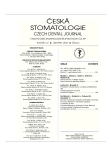Corrosive Behaviour of Dental Ceramic Material In-Ceram Spinell in Selected Beverages and Solutions in vitro
Authors:
L. Vavřičková 1; A. Krejčová 2; M. Pokorná 2; T. Dostálová 3
Authors‘ workplace:
Stomatologická klinika, LF UK a FN, Hradec Králové
1; Ústav environmentálního a chemického inženýrství
Fakulta chemicko-technologická, Univerzita Pardubice
2; Dětská stomatologická klinika 2. LF UK a FN Motol, Praha
3
Published in:
Česká stomatologie / Praktické zubní lékařství, ročník 112, 2012, 6, s. 173-181
Category:
Original Article – Experimental Study
Věnováno k významnému životnímu jubileu prof. MUDr. Jany Duškové, DrSc., MBA
Overview
Introduction:
The biocompatibility of ceramic materials belongs to the best benefits of these dental materials.
Aim:
Paper presents in vitro corrosive behaviour testing procedure of ceramic dental material in preselected beverages and solutions.
Methods:
The ceramic material In-Ceram Spinell (Vita, Germany) was immersed using following leaching agents: Ice Tea Peach (Lidl Stiftung & Co. KG, DEU; pH 2.99), Freeway Cola (Lidl Stiftung &Co. KG, DEU; pH 2.42), red wine Cabernet Sauvignon (Wine Cellars Peter Metres KG; pH 3.59), white wine (Israel; pH 3.23), juice 100% orange (Relax Ltd., NZL; pH 3.76), mouth wash Colgate Plax Whitening (Colgate – Palmolive, SUI; pH 8.04), 0.9% NaCl (pH 5.35), 0.5% acetic acid (pH 2.56), 2% citric acid (pH 1.98), 0,1M HCl (pH 1.54), redistilled water (pH 5.70). Samples of the mentioned material were immersed at 37 °C during seven days. The change of sample masses and the change of colour was followed. After immersion test, leaching agents used we analysed using inductively coupled plasma optical emission spectrometry (ICP OES) and the increase in concentration of chosen elements was monitored.
Results:
The highest loss up of sample masses was found for samples tested in citric acid. The loss of material mass is related to pH. The colour change was monitored in samples treated in Freeway Cola and red wine, they came under different colour changes. ICP OES analysis demostrated the increase in concentration of calcium, magnesium, aluminium, yttrium, silica and other elements in extracts.
Conclusion:
Though the dental ceramics is considered to be bioinert, the corrosive behaviour of In-Ceram Spinell was monitored in the presence of currently used beverages and solutions.
Key words:
elementary analysis – optical emission spektrometry – dental ceramics – In-Ceram Spinell – immersion test – corrosion
Sources
1. Anusavice, K. J.: Degradability of dental ceramics. Adv. Dent. Res., 1992, č. 6, s. 82–89.
2. Anusavice, K. J., Zhang, N. Z.: Chemical durability of Dicor and lithia-based glass ceramics. Dent. Mater., roč. 13, 1997, č. 1, s. 13–19.
3. Hammerle, C., Sailer, I., Thoma, A., et al.: Dental Ceramics. Quintessence Publishing, 2008, s. 1–10, ISBN 987-1-85097-181-8.
4. Hsu, H. C., Yen, S. K.: Evaluation of metal ion release and corrosion resistence of ZrO2 thin coatings on the dental Co-Cr alloys. Dent. Mater., roč. 14, 1998, č. 5, s. 339–346.
5. Chong, K. H., Chai, J., Takahashi, Y., Wozniak, W.: Flexural strength of In-Ceram alumina and In-Ceram zirconia core materials. Int. J. Prosthodont., roč. 15, 2002, č. 2, s. 183–188.
6. Jakovac, M., Živko-Babic, J., Curkovic, L., Aurer, A.: Measurement of ion elution from dental ceramics. J. Eur. Cer. Soc., roč. 26, 2006, č. 9, s. 1695–1700.
7. Kukiattrakoon, B., Hengtrakool, C., Kedjarune-Leggat, U.: The effect of acidic agents on surface ion leaching and surface characteristics of dental porcelains. J. Prosthet. Dent., roč. 103, 2010, č. 3, s. 148–162.
8. Milleding, P., Haraldsson, C., Karlsson, S.: Ion leaching from dental ceramics during static in vitro corrosion testing. J. Biomed. Mater. Res., roč. 61, 2002, s. 541–550.
9. Milleding, P., Karlsson, S., Nyborg, L.: On the surface elemental composition of non-corroded and corroded dental ceramic materials in vitro. J. Mater. Sci. Mater. Med., roč. 14, 2006, č. 6, s. 557–566.
10. Milleding, P., Wennerberg, A., Alaeddin, S., Karlsson, S., Simon, E.: Surface corrosion of dental ceramics in vitro. Biomaterials, roč. 20, 1999, č. 8, s. 733–746.
11. Ryge, G., Cvar, J. F.: Criteria for clinical evaluation of dental restorative materials. US Dental health Center, Publication No.7902244, San Francisco, USA, 1971.
12. Vavřičková, L., Dostálová, T., Krejčová, A., Šrámková, J., Slížová, D.: Koroze keramických materiálů. LKS, roč. 22, 2012, č. 4, v tisku
13. Vavřičková, L., Pilathadka, S., Dostálová, T.: Celokeramické systémy v klinické praxi. LKS, roč. 18, 2008, č. 10 (suppl.), s. A5–A11.
Labels
Maxillofacial surgery Orthodontics Dental medicineArticle was published in
Czech Dental Journal

2012 Issue 6
- What Effect Can Be Expected from Limosilactobacillus reuteri in Mucositis and Peri-Implantitis?
- The Importance of Limosilactobacillus reuteri in Administration to Diabetics with Gingivitis
Most read in this issue
- Rare Tumours in Maxillary Region
- Caries Experience in Czech Preschool Children
- Risk Factors of Dental Caries Development in One-Year Old Infants
- Nanotechnology in Dentistry
